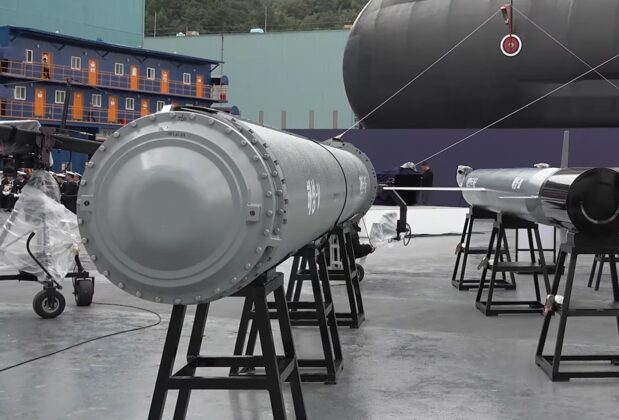
Republic of Korea Navy and the Defense Acquisition Program Administration (DAPA) unveiled the first Changbogo-III Batch-II class submarine, the Jang Yeong-sil (SS-087), at Hanwha Ocean’s Geoje Shipyard, and displayed the Haeseong‑5 anti‑ship missile as a central part of the ceremony.
The missile, shown alongside the new submarine, is presented as a supersonic, mid‑range cruise and anti‑ship weapon that officials link to technology derived from the Russian Yakhont family.
The Haeseong‑5 was shown in the context of the submarine’s mid‑aft 10‑cell ULS‑07K vertical launch system, indicating an internal launch option for the platform’s strike loadout.
According to the open source material, the missile is a supersonic universal anti‑ship weapon intended to engage surface warships and single ships under heavy fire and electronic countermeasures; the same sources say it can also be used against land targets and that its engagement range can be increased for such missions.
The design described for Haeseong‑5 follows a conventional aerodynamic layout and uses a solid‑fuel booster placed inside the combustion chamber of a ramjet engine. The booster burns to accelerate the missile; once the booster stage completes, it separates under the oncoming airflow, allowing the ramjet to operate in sustained cruise. That propulsion arrangement is consistent with other supersonic cruise designs that combine a short‑burn solid motor for launch with an air‑breathing second stage for high‑speed cruise.
The public display of Haeseong‑5 on a Changbogo-III Batch-II class submarine underscores Seoul’s emphasis on putting more strike options aboard its next‑generation submarines. The Changbogo-III Batch-II class is intended to expand the Republic of Korea Navy’s undersea strike and deterrent posture by increasing missile payloads and onboard systems integration compared with previous batches. The presence of a 10‑cell ULS‑07K launcher on the mid‑aft deck signals that the platform can carry a mix of anti‑ship and land‑attack munitions without relying solely on torpedo tubes.
From a technical perspective, combining a solid booster with a ramjet offers distinct operational trade‑offs. The booster provides rapid acceleration and initial launch energy, while the ramjet can sustain supersonic cruise at altitude or near sea level. That profile can complicate interception and may place different demands on warning and engagement chains for regional defenses. The use of a vertical launch system on a submarine, rather than winged or tube‑launched designs alone, changes how commanders may plan loadouts and employment.